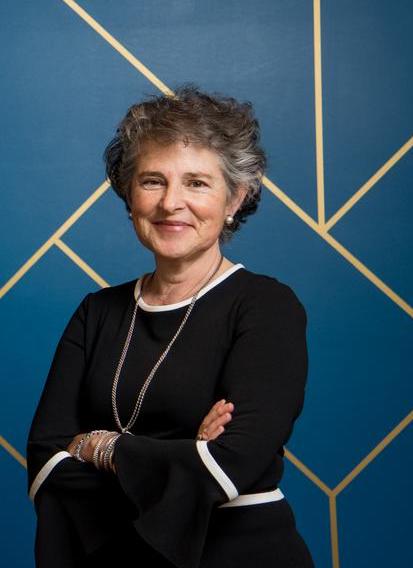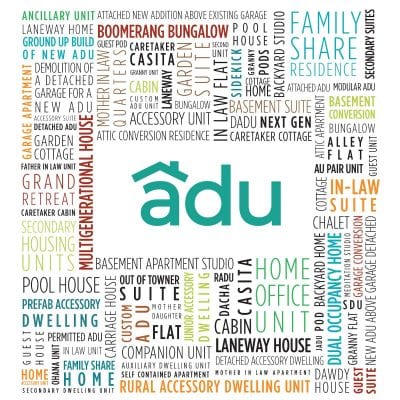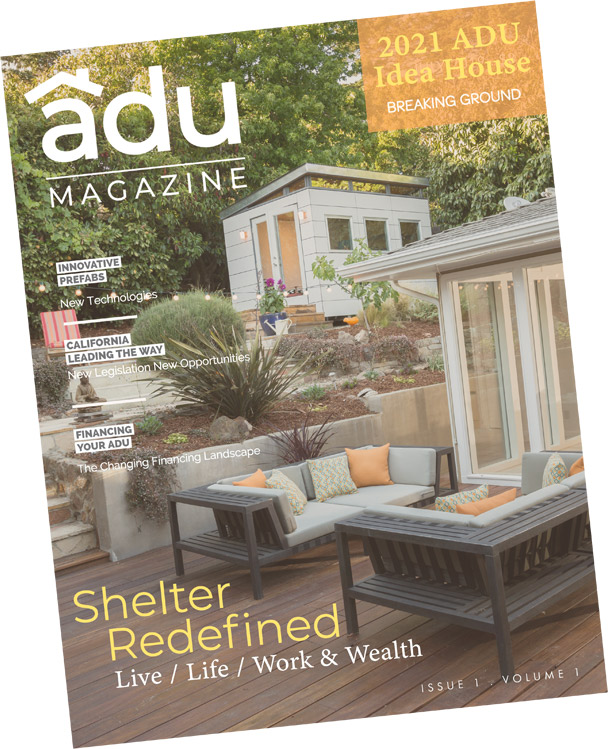Denise Pinkston
California has more accessory dwelling units than any state in America. One person with a keen understanding of why this is? Denise Pinkston.
Pinkston is founder and board president of the Casita Coalition, a statewide non-profit based in San Francisco that formally launched in January 2020, advocating for ADUs and affordable housing. ADU Magazine spoke with Pinkston about her organization’s genesis, the need for ADUs in California, and much more. Following find selected highlights and excerpts of that Question & Answer Session.

The additional increment of AB 68 saying you have to allow a freestanding backyard cottage and a junior accessory dwelling unit on the same property, we won’t know the full extent of that impact for a couple of years. But I guarantee you it will yield tens of thousands if not hundreds of thousands of accessory units across the state in a very, very short time, particularly with COVID.
– Denise Pinkston
ADU Magazine: What led to the formation of the Casita Coalition?
Denise Pinkston: The reasons for founding the non-profit were many of us have been involved in ADU advocacy, education, homeowner assistance, (and) building for years, in our own communities.
What we realized, as some of us got more involved in the state legislative efforts, was that there were people just like us right across the city lines, or in other parts of California. It makes all the sense in the world for us to all be talking to each other statewide to see what we are finding, what barriers we’re finding to homeowners getting ADUs, what difficulties they, what their challenges are, and then seeing if we can find statewide solutions that are helpful at removing those barriers.
That’s what brought us together was the idea that the whole was greater than the sum of the parts and we’re stronger together than we are separate. That (vision) is really what led to the statewide ADU legislation that it really is helpful when there’s clarity and consistency of rules for these small housing forms that are almost invisible in existing neighborhoods, that fit in seamlessly, and really are designed to help families and are very popular.
Having consistent, statewide standards across all cities makes getting these things built much more efficient, manageable for homeowners, and it allows businesses to scale up and start delivering services to homeowners who live in all sorts of places in California.
ADU: How closely was your group or some of the individual members in it working with state lawmakers like Assemblymember Phil Ting and Sen. Bob Wieckowski who’ve authored ADU bills to get some of the legislation passed?
Pinkston: Very closely. I was the technical advisor to both Sen. Wieckowski and Assemblymember Ting and was really intimately involved in drafting the text of those two bills as well as working through issues that arose during the legislative process, helping to evaluate the post amendments, and making sure they made sense based on what people are seeing on the ground, helping get communities engaged in the legislative process so that everyone had their voices represented as the process unfolded. So, we worked together very collaboratively with the Legislature.
ADU: How much was the legislation needed for ADUs?
Pinkston: Oh, it was critical. California would not have tens going on hundreds of thousands of accessory dwelling units if it had been for the state laws, particularly Sen. Wieckowski’s first bill, SB 1069 and Assemblymember Ting’s really landmark bill, AB 68. Without those two bills, you wouldn’t have the kind of ADU popularity and ability to deliver across all 450 cities in the state of California.
ADU: How long have some of your individual members been advocating for housing?
Pinkston: Well, individual members, some of them, have made a whole career of it. The housing problem has been decades, generations in the creation, and it’s going to take us decades to work out solutions.
I started with a background in local government. That’s where I began my career and realized that getting a permit from local government is a terrifying experience if you’re a homeowner and you’re not a professional. It doesn’t have to be. And I think there’s a lot of goodwill in local government to make it easier. It’s just difficult. It’s difficult to work through the community concerns.
The advantage of uniform rules at a statewide level is that it doesn’t require 450 cities to individually come up with different ideas about how to do it that creates confusion between cities. It creates some uniformity of standards for this very small, simple housing form that then allows homeowners and lenders and businesses to start really helping get them built.
ADU: With California having so many ADUs, is that just a facet of the state having 40 million people or are ADUs more popular here even per capita than they are in the rest of the country?
Pinkston: There is no other state in the US that allows ADUs uniformly across the state. There are states in the US where there are cities that are very pro-ADUs. Portland, Seattle, Vancouver — Vancouver’s not in the US, obviously. But there are cities and regions that allow these. New South Wales, Australia, which is kind of like a state in Australia allows ADUs by building permit.
In the places that have allowed these by building permit for a time, as much as 20-25 percent of the housing stock in these communities has an ADU. In California, we have 7 million single-family homes. If 20 percent of California homes had an ADU, that would be (1.4 million) places for people to live. So, the potential impact at the state level is enormous if every community is following the same playbook.
What you find in the ADU history if you look at studies done by say Karen Chapple at UC Berkeley or Jake Wegmann who’s now at UT Austin, their studies show that where cities don’t allow ADUs easily — i.e. they have really impenetrable zoning standards, minimum lot sizes that are very large, parking requirements that homeowners can’t meet (because) they can’t fit more parking on their property, extremely high impact fees — those kinds of zoning standards make it impossible for homeowners to realistically add accessory units legally. So, what you find in those places, the homeowners do it illegally because they can’t get it to the point where it would be allowed.
In many communities and in communities of color in California, ADUs have been around for a long time. People just couldn’t talk about it…
Even in wealthy communities in California, people’s backyard cottages were, they hid them from their neighbors but all the neighbors knew… When we ran the first ADU bill, people confessed that, ‘Yeah, we all have illegal ADUs. When the building official comes to look at somebody’s roof, we tell our tenants to stay in for the day.’
We were forcing good citizens to lie about their behavior, which was borne of necessity. They needed more money to pay their mortgage or they had a family member who had nowhere else to go. You shouldn’t have rules that turn a good deal of your population into scofflaws when they’re just trying to do the right thing.
Having statewide standards makes it really easy for people to make their units legal. And then in communities of color particularly, where there may be a language barrier or fear that going to government’s going to get you in trouble, having clear rules that make it legal is helping lower income homeowners develop ADUs cost-effectively and safely.
I’m going to send you an article…that was just out last week, it basically says, here’s a couple of case studies of people doing ADUs in Fresno, sometimes illegally with family and friends providing labor and a fear that if they go to the city, the city won’t let them do it. And then the city saying, ‘Hey, we have these new rules now. We’ll actually try to help you legalize your unit because we can. The zoning barriers are gone. State legislation got rid of the zoning barriers. Now, what you need is a building permit so it’s safe.’
That’s why California is leading the nation, because we were the first state in the US to have clear, statewide standards.
ADU: San Francisco’s got to be one of the ground zeros for ADUs, I would think.
Pinkston: You know, it’s funny. I think the Bay Area has a lot, but LA has a huge number as well. The Jake Wegmann study that I mentioned said that 50 percent of housing built in the cities of Bell, which are kind of around Knotts Berry Farm in Los Angeles, lower-income, Latino-mostly homeowner neighborhoods, half the housing there was illegal ADUs …
In lower-income communities where people are more at risk of losing their home because they can’t pay the mortgage, they need the income stream that an ADU provides just to hang onto their house. Now, they can. Now, they can do that legally.
In my neighborhood, there were some older homeowners that are seniors and they live on a fixed income. They’re concerned about whether they’re going to be able to retire on their fixed income and remain in the Bay Area. To them, an ADU is a way of making sure that they can take care of themselves. And maybe they move into the ADU and rent the house to a family.
It’s allowing lower-income homeowners, homeowners on a fixed income the flexibility to move from a big house when you don’t need it anymore to a smaller house, to welcome a family, to kind of have social connections, and to make sure you don’t lose your home when there’s an economic upset in your life — whether that’s medical care or a pandemic that threatens your source of income so your house is then at risk.
ADUs give families the flexibility to take care of their family members and to allow family needs to change over time. It’s a really great strategy that helps homeowners at all levels of the income scale just have a little extra certainty and flexibility with the home that they own so they can keep it.
ADU: Tell me a little more about the genesis of your organization, what got it together, and what your vision is today.
Pinkston: Well, we were all very passionate about trying to find constructive solutions to the housing crisis that actually work. A number of us were retired and had worked in planning or housing for our professional career and felt really sad and unhappy about the (situation) of California and the state of families.
I think in the Bay Area, something like 50 percent of seniors are at risk of being homeless because they’re on a fixed income and if they have a medical bill and they can’t pay their mortgage, they’ve got nowhere to go and they can’t pay rent. It’s just hard to live in a community knowing that that’s true without trying to be helpful.
A lot of us were motivated out of a deep concern about the state of affairs of housing in California and families and seniors and homelessness and wanting to find something we could do to be helpful. That something seemed to be ADUs because people can afford to build them. Now they’re legal. And what’s needed is some extra help, maybe technical assistance, maybe there are still barriers that need to be removed.
So we formed together out of that deep concern for finding workable solutions to the housing crisis to promote smaller homes, ADUs, tiny homes, and so forth as a solution to the housing crisis that everyone can help with. You don’t have to wait for government to hand out money. Homeowners can do it today. You don’t have to work with someone else to solve the housing crisis. You can solve it today in your backyard.
And that kind of ‘We’re all in this together and we can all make a difference’ attitude is really the galvanizing force behind the members of the Casita Coalition … By working together across the state of California, we can have a tremendous impact and do a whole lot of good.
ADU: Regarding the $700,000 your organization has raised since January, what does your organization do with the funds?
Pinkston: We’ve raised money primarily (through) three foundations. Our first grant was from the Chan-Zuckerberg Initiative. Our second and third were from the San Francisco Foundation and the James Irvine Foundation.
Those grants were to get us up and running so that: homeowners regardless of their income and regardless of what community they live in in California have access to free information and technical assistance that will help them understand how they might benefit and be able to build an ADU; to help cities implement best practices to help owners develop these and permit them; and helping explain some of the challenges and barriers that remain still for homeowners like, how do you pay for it and how do you design it; and working statewide in coalition to find the best and the brightest ideas being innovated in California cities.
And there’s some really terrific innovations going on throughout the state and hold those up and share them so everyone can benefit from great ideas that cities are developing on the ground. San Mateo has a great ADU resource center that they opened. Napa-Sonoma County has done a fabulous ADU accelerator program with a really good website.
The city of Los Angeles has been extremely innovative and gotten Bloomberg Foundation matching grants to do their ADU accelerator and to (specifically) target assistance into low-income, homeowner neighborhoods in Los Angeles. San Diego has done, in fact today there was a headline in the papers in California that San Diego is one of the first cities to allow real tiny homes as accessory dwelling units because they’re the most cost-effective way to put a second home in your backyard.
We really loved the idea that cities are doing terrific work and everyone should see what they’re up to so that they can follow the lead of people who are doing interesting things already rather than having to reinvent the city in 450 different cities across the state.
ADU: ADUs can be pretty expensive, sometimes over $100,000. What sorts of things does your group advocate for to defray the price or make it easier for lower-income people to be able to construct ADUs?
Pinkston: I think that’s a really good question and that’s one of the remaining barriers that we are working on right now.
One of (the barriers) is to encourage more banks to provide loans to lower-income homeowners to build ADUs. Today, if you have a home equity line of credit and a lot of equity in your home, you can borrow the money you need to build an ADU. You don’t have to be sitting on $100,000 in cash.
But if you don’t have enough money to pay off that loan, if you’re on a fixed income or have a lower income, you can’t borrow money based on the potential income stream of the ADU to be able to go build it. One of the things we’re working on is we’re working to encourage lenders to step into the space and expand the program and then helping them publicize their programs when they do. They can help people get financing.
This is a new industry. AB 68 just passed last year and took affect in January. This idea that you could build a freestanding accessory unit in somebody’s backyard was really less of a thing until AB 68 passed.
Now that it passed, lenders are taking notice, venture capitalists are taking notice, there are new business models cropping up daily it feels like to bring down the cost of building an ADU and make it easier for homeowners to finance them and to get one built. That innovation, that industry innovation is going to go on for years and every time a bank develops a new, lower-cost loan product or a modular company comes up with a better way to build a super cost-effective way to build an ADU, that’s going to lower the cost to the homeowner ultimately.
We want to help encourage, guide, and roll out all of these innovations so that homeowners don’t have to pay as much money to secure an ADU and it’s more like, today you can buy a car online and they’ll deliver it to your house. Five years from now, you should be able to buy an ADU online and have somebody deliver it to your backyard. It should be not a whole lot more difficult. Yeah, there’ll be a foundation, there’ll be a few other bells and whistles. But it should become much easier, much more cost-effective, and much more automated over time.
And there will always be some ADUs that are more curated, that are designed by an architect and link the architecture of the ADU to the architecture of the home. And that’s terrific. There’s lots of room for lots of ways to do this. But right now, industry’s trying to bring the cost down so more people can afford to do these. There’s a number of companies in that space … they’re going to keep working really hard to … make it more cost-effective for homeowners.
ADU: What’s it been like to try to get lenders onboard with ADUs?
Pinkston: I think there’s a tremendous amount of interest. The question is, Dodd-Frank has some prohibitions against lending on future income. So, it’s about lenders getting creative on how to do this.
For example, Umpqua Bank…has developed a renovation loan that can be federally insured that can be used to build an ADU. That product is available today in California. There are other lenders that are making ADU loan products available but they’re doing it in creative ways that aren’t obvious.
And there’s no point in the lender developing a program if only one homeowner per city can ever build an ADU, which was pretty much the state of affairs prior to Sen. Wieckowski’s bill. There’s no point in spending all the brain (resources) in developing a program, if all you’re selling the program to is one homeowner in every city. There’s no business model there.
Now that ADUs can be built everywhere, in the thousands, that’s now a business model that lenders can get into.
ADU: You mentioned about having a background in local government. Why do you think by and large it took local government so long to get to the table with ADUs? What were some of the barriers?
Pinkston: I think part of it was that it hasn’t in California, for whatever reason, gotten the attention it deserved. So, we put the issue front and center in the state… It needed to come to California, if you will, as a really viable solution to the housing crisis. That’s what we did with SB 1069 is really bring this issue to the fore in the state of California.
I think that the current generation of the housing crisis has gotten worse more quickly than professional planners could possibly have envisioned 10 years ago. The degree with which the problem has exploded and gotten out of control has required … creative solutions that can be difficult and politically challenging in some communities.
A number of California counties were very forward-thinking in ADUs. Napa, Sonoma, Marin all had very progressive accessory dwelling unit policies before the state ever got into the space. So did Berkeley, San Diego. Other communities just couldn’t get there. Their elected officials or their neighborhood associations just didn’t think this was a good idea and they could not get to a political agreement to allowing this housing form to proceed.
In Los Angeles, ADUs were hung up for years in litigation and the city council wasn’t able to successfully chart a path forward until the state created a level playing field for all cities. LA relies on the state ADU laws to create their standards. As a result, Los Angeles has more ADUs than almost any community in the state. It’s astronomical. They’ve got like 4,000 or 5,000 accessory dwelling units per year in building permits over the last three years for 15,000, going to 20,000 and more in the city of Los Angeles alone — almost as many ADUs as they have multi-family building permits.
It’s just that every community’s different and the politics of communities is different and they tend to be governed by the people who live there already who tend to want to keep things the way they are and don’t really have a reason to want to solve the housing crisis for someone else. I think in that kind of a circumstance, you need state legislature to step in and say the housing crisis is a problem for all of us and we all need to solve it together.
That’s what California did. It provided policy leadership that was really necessary and once the state took that leadership position, cities were able to get onboard very quickly.
ADU: In the state legislature, Nancy Skinner and Richard Bloom have also done some ADU legislation. Are you familiar with the work that they’ve done?
Pinkston: Yeah. Richard Bloom has had a number of very good and helpful ADU bills over the years. He had a bill the same year that Sen. Wieckowski did, he had a bill last year that worked on the issue of owner occupancy. That was part of the suite of ADU bills.
He’s been a really powerful ADU advocate and friend of ADUs in Southern California. I’ve really been impressed with the penetration and the speed with which ADUs are rolling out in his district, which is the west of Los Angeles, in Santa Monica.
Sen. Skinner had a bill which was basically in parallel with AB 68 at the time, the first time that AB 68 was introduced. She worked closely with Assemblymember Ting this year and the year before. She was a cosponsor and advocate for the full suite of ADU bills.
ADU: What were some of the things that you were hoping to talk about today that we haven’t gotten to yet?
Pinkston: I think the main message I want to leave you is that the next big step for ADUs to continue to roll out in California is for homeowners to know about them, to understand the details of how to get one built, and for cities to be able to provide good homes to homeowners when they come to city hall to get a permit so these things are done safely and legally.
The Casita Coalition, that’s where we help. We’re here to help cities and homeowners find a way forward because we think that these small housing solutions are tremendously powerful. We like to say that this is the big power of small homes.
ADU: Let me ask you a few more questions related to lower-income communities and communities of color. For getting more ADUs or more permitted ones in those communities, how much of it is about getting the financial piece up, how much is about raising awareness, and then are there other factors as well that you see?
Pinkston: I think it’s all of the above. In any situation where there are many barriers that form an impenetrable wall, you gotta take the barriers down one or two bricks at a time. And sometimes, you take part of the barrier wall down and you realize there were more things in the way than you knew.
So, the state took away the zoning barriers with the round of state legislation that got rid of the most difficult zoning barriers to ADUs and also reduced fees, allowed them to be leased without owner occupancy. There were a lot of innovations … the state of California’s really done some great work on this.
Now that those barriers are gone, we’re seeing the next ones, the ones you couldn’t fix through state laws. So lending barriers, and we are working with lenders. Remaining costs, costs are high not everyone can afford it, so we’re working on how can you bring the cost down.
A lot of (the remaining barriers relate to) awareness. Some of the ADU companies that are members of the Casita Coalition report to us that the No. 1 reason that they reach out to homeowners and they’re hesitant is they (the homeowners) can’t believe it’s true. They don’t know about the state law changes and they haven’t heard of it.
If someone calls you and says, ‘Hey, we’d like to be your ADU builder. We will essentially pay to build and bring an ADU to your backyard. And you’ll collect the rent.’ Homeowners will respond by saying, ‘That sounds too good to be true.’ They’re rightly skeptical. But a lot of the skepticism, we can take that away once people know.
One of the huge advantages of your magazine and something Casita Coalition is going to work on is homeowner awareness. What are the rules? What can you do? What is equity stripping and how can you avoid it? Right now, no one knows and you can’t get good information. We just want there to be good, transparent, reliable information from a trusted source so homeowners know no one is trying to take advantage of them. We just want to get the word out.
Really the work of the Casita Coalition over the next couple of years is to create that trusted source of information and get the word out.
ADU: I wanted to close by asking about your vision for the road ahead. It sounds like a lot of it is education. What other things are you hoping will happen for your organization in the next few years?
Pinkston: We hope to run homeowner awareness campaigns statewide to raise homeowner awareness about the laws and how to access them. We hope to work with lenders and financial institutions to make loan products that don’t involve equity stripping more widely available so more people can take advantage of these laws.
And we hope to do particular work in low-income communities and communities of color to do technical assistance to the cities and to homeowners and to community organizations in those cities to make sure that folks who may not have the ability to hire an architect to take care of this for them nevertheless have the ability to access the new law changes and to bring the benefits of these small housing forms to their communities.
* This interview has been edited for length and clarity.







